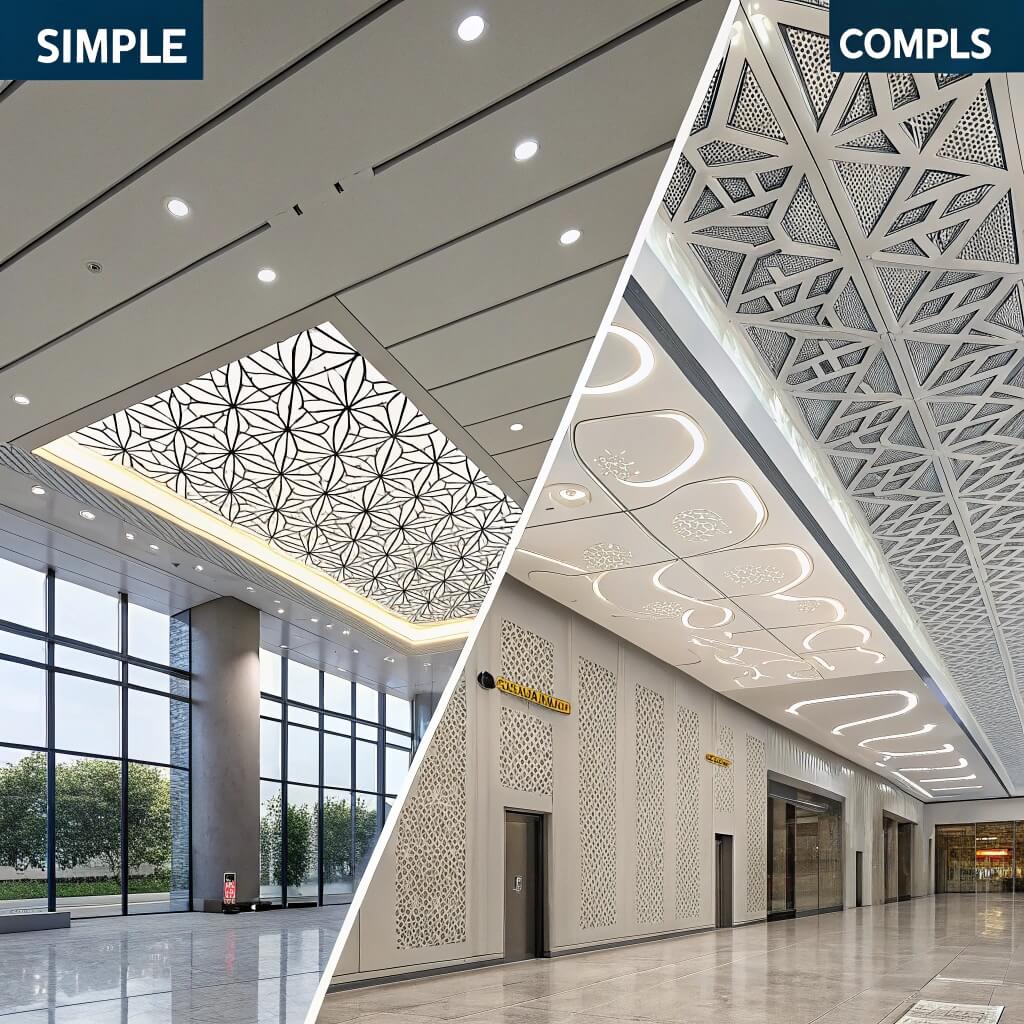What is an aluminium strip ceiling?

A messy or outdated ceiling design can make a space look old, dark, or even unprofessional. That’s a big problem for commercial projects or public buildings.
An aluminium strip ceiling is a ceiling system made of long, narrow panels of aluminum, used for modern architectural decoration. It’s lightweight, durable, and ideal for clean, linear designs.
If you’re looking for a ceiling system that’s both functional and visually striking, aluminium strip ceilings are a smart choice. They are popular in airports, malls, offices, and high-end interiors because they combine clean lines with strong performance.
What is the price of aluminum baffle ceiling?
A lot of buyers hesitate to choose aluminum baffle ceilings because they worry about the price. They often think it might be too expensive for their project budget.
The price of an aluminum baffle ceiling typically ranges from $15 to $40 per square meter, depending on design, thickness, coating, and customization level.

To understand the price, we need to look at the factors that affect it:
1. Material thickness and type
| Thickness (mm) | Surface Finish | Estimated Price (USD/m2) |
|---|---|---|
| 0.4 | Powder Coated | $15 – $20 |
| 0.6 | PVDF Coated | $20 – $30 |
| 0.8 | Wood Grain Finish | $25 – $40 |
Thicker panels are more durable and expensive. The type of surface finish also matters. PVDF coating lasts longer, while wood grain effects are more decorative.
2. Customization level
Custom colors, sizes, or curved shapes can increase cost. If you need something unique for a special project, be prepared for a higher budget.
3. Order quantity
Large orders usually come with discounts. Small batch orders may cost more due to setup fees and logistics.
From my experience working with buyers like Daniel from Singapore, project timelines often affect pricing too. If a buyer needs fast delivery, express production and shipping fees can raise the final cost.
What is an aluminium strip?
When architects or buyers hear "strip," they often get confused. Some think it’s a random metal piece. Others don’t know how it fits into the ceiling system.
An aluminium strip is a long, narrow piece of aluminum, often used as a component in strip ceilings or as decorative trim in ceilings and walls.

Aluminium strips come in various widths, finishes, and edge shapes. In ceiling systems, we use them in these ways:
Types of aluminium strips used in ceilings
| Type | Width (mm) | Common Use |
|---|---|---|
| U-Shape Strip | 30-100 | Exposed linear ceiling designs |
| Box Strip | 50-150 | Baffle ceilings or open-type panels |
| V-Shape Strip | 30-80 | Light-reflecting or shadow effects |
Each type gives a different visual effect. The "strip" concept allows for open or semi-open ceiling systems. That helps with air circulation and acoustic control.
I once worked with a U.S. designer, Emily, who wanted a ceiling that allowed light fixtures to be mounted in between the strips. Aluminium strips made that design possible with clean spacing and flexible layout.
What is a strip ceiling?
Some clients hear "strip ceiling" and think it’s just a decorative idea. But it’s actually a whole system with specific parts and installation needs.
A strip ceiling is a suspended ceiling system made of long, narrow panels (strips) installed in parallel, often made from aluminum or steel.

These ceilings are often chosen for modern commercial spaces. They are practical and stylish. The gaps between strips can be open or covered, depending on the design.
Benefits of strip ceilings
- Easy maintenance: Panels can be individually removed for access.
- Modern aesthetics: Clean, linear look suits high-end spaces.
- Customizable layout: Adjust spacing, angles, or colors as needed.
- Sound control: Combine with acoustic pads for noise reduction.
From experience, strip ceilings are a hit in airport terminals, like those in Singapore or Japan. The panels guide movement visually and give a spacious feeling.
How to install metal ceiling?
Many buyers worry about metal ceiling installation. They think it’s complex or requires high labor skills. That can cause hesitation during decision-making.
To install a metal ceiling, you need to fix the carrier system first, then clip or lock the metal panels into place according to layout drawings.

Let me break it down step by step:
Basic steps to install metal strip ceiling
- Mark the ceiling level: Use laser or chalk line on the wall.
- Install suspension rods: Fix hangers to the concrete slab.
- Fix the main carrier: Attach aluminum runners or keels to the rods.
- Add cross carriers (if needed): Support system based on panel size.
- Install ceiling panels: Clip, lock, or screw the panels into place.
- Adjust gaps and alignment: Ensure straight and consistent spacing.
Tools and materials needed
| Item | Function |
|---|---|
| Laser level | Marks ceiling level accurately |
| Drill + anchor bolts | Fix hangers securely |
| Ceiling clips | Attach panels to carrier |
| Aluminum carriers | Hold the ceiling structure |
Some of my clients like Kenta from Japan are very focused on precision. They often ask for detailed installation instructions and videos. That’s why we always include diagrams and technical support for every order.
Conclusion
Aluminium strip ceilings are smart, modern, and flexible. They fit many commercial and public projects. With clear understanding of pricing, structure, and installation, you can confidently choose the right system for your needs.



